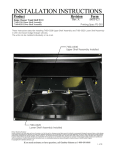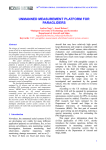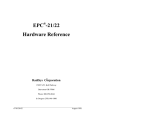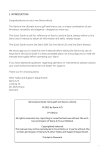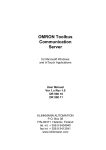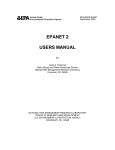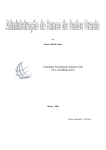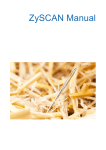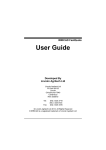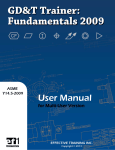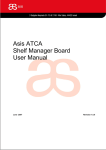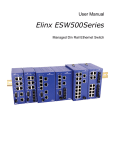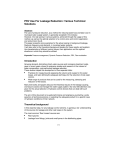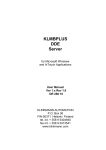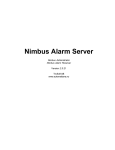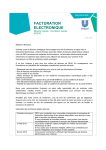Download PRV DDE I/O Server
Transcript
PRV DDE I/O Server
for use with Siemens Landis & Staefa PRV building automation devices
User and installation manual
Revision history
Version
Preliminary
Release
1.00.00.0
1.00.00.6
1.00.00.20
1.00.00.22
1.00.00.25
Date
June 1999
September 1999
May 2000
November 2000
April 2005
October 2005
March 2007
Author
Tomas Rook
Tomas Rook
Tomas Rook
Tomas Rook
Tomas Rook
Tomas Rook
Tomas Rook
TroSoft PRV DDE I/O Server - Installation and User Manual
Reason
First release
Revision
Event based / persistant cache
New parameters
Setup revision
New parameters
New parameters
2
1
ABOUT THE PRV DDE I/O SERVER ........................................................................................... 7
2
WHAT IS DDE ? ............................................................................................................................... 8
3
4
2.1
CLIENT AND SERVER .................................................................................................................... 8
2.2
APPLICATION, TOPIC AND ITEM .................................................................................................... 8
2.2.1
Application ........................................................................................................................... 8
2.2.2
Topic .................................................................................................................................... 8
2.2.3
Item ...................................................................................................................................... 8
INSTALLATION ............................................................................................................................... 9
3.1
BEFORE YOU START ...................................................................................................................... 9
3.2
HOW TO INSTALL .......................................................................................................................... 9
3.2.1
Setup of INI-file .................................................................................................................... 9
3.2.2
Licensing .............................................................................................................................. 9
3.2.3
Files in the PRV DDE I/O Server installation directory...................................................... 9
HARDWARE REQUIREMENTS ................................................................................................. 10
4.1
HARDWARE REQUIREMENTS, DIRECT (METHOD 1)...................................................................... 10
4.1.1
5
6
Cabling .............................................................................................................................. 10
4.2
HARDWARE REQUIREMENTS, MULTIDROP (METHOD 2) .............................................................. 11
4.3
HARDWARE REQUIREMENTS, TCP/IP (METHOD 3) ...................................................................... 12
4.4
HARDWARE REQUIREMENTS FOR THE PRV ................................................................................. 13
4.5
PC HARDWARE KEY REQUIREMENT ............................................................................................ 13
4.5.1
Other licensing methods .................................................................................................... 13
4.5.2
License add-ons ................................................................................................................. 13
4.5.3
Demo mode ........................................................................................................................ 14
SOFTWARE REQUIREMENTS ................................................................................................... 15
5.1
RESOURCE REQUIREMENTS ........................................................................................................ 15
5.2
LIMITATIONS .............................................................................................................................. 15
CONFIGURATION ........................................................................................................................ 16
6.1
CONFIGURATION OF THE PRV DDE I/O SERVER, DIRECT (METHOD 1) ...................................... 16
6.2
CONFIGURATION OF THE PRV DDE I/O SERVER, MULTIDROP (METHOD 2) ............................... 16
6.2.1
Configuration of the KD485-ADE, Multidrop node .......................................................... 17
6.2.2
Timeslots ............................................................................................................................ 18
6.3
CONFIGURATION OF THE PRV DDE I/O SERVER, TCP/IP (METHOD 3) ...................................... 19
6.3.1
6.4
Configuration of the Terminal Server, TCP/IP .................................................................. 19
OTHER SETTINGS ........................................................................................................................ 19
6.4.1
DefaultPolled ..................................................................................................................... 19
6.4.2
PreventWriteOfSameValue ................................................................................................ 20
6.4.3
ProtocolTimer .................................................................................................................... 20
6.4.4
RequestTimer ..................................................................................................................... 20
TroSoft PRV DDE I/O Server - Installation and User Manual
3
7
6.4.5
ValidDataTimeout .............................................................................................................. 20
6.4.6
RefreshTimer ...................................................................................................................... 20
6.4.7
RefreshSpan ....................................................................................................................... 20
6.4.8
TCPErrorTimer ................................................................................................................. 21
6.4.9
StartupHideTimer .............................................................................................................. 21
6.4.10
ShowSend, ShowReceive, ShowErrors, ShowEvents, ShowStatistics ................................ 21
6.4.11
KeepUsedPortsOpen .......................................................................................................... 21
6.4.12
RememberEventItems......................................................................................................... 21
6.4.13
AddressByte ....................................................................................................................... 21
6.4.14
DisableNagleAlgorithm ..................................................................................................... 21
6.4.15
ForceUpdateInterval ......................................................................................................... 22
6.4.16
ManuallyStripNulls ............................................................................................................ 22
6.4.17
ERSTAAlwaysDigital ......................................................................................................... 22
6.4.18
RegistrationCode ............................................................................................................... 22
CONFIGURATION OF THE PRV ............................................................................................... 24
7.1
BAUD RATE SETTINGS ................................................................................................................. 24
7.2
SPECIAL CONSIDERATIONS FOR PRV2 ........................................................................................ 24
7.3
EVENT UPDATE METHOD ............................................................................................................. 24
8
7.3.1
First time polls ................................................................................................................... 25
7.3.2
Refresh of event based Items .............................................................................................. 25
7.3.3
Persistant Items.................................................................................................................. 25
RUNNING THE PRV DDE I/O SERVER .................................................................................... 26
8.1
STARTUP ..................................................................................................................................... 26
8.2
MAIN WINDOW ........................................................................................................................... 27
8.3
SYSTEM MENU ............................................................................................................................ 27
8.3.1
Statistic performance ......................................................................................................... 28
8.4
HELP MENU ................................................................................................................................. 28
8.5
FILE MENU .................................................................................................................................. 29
9
8.5.1
Refresh event based Items .................................................................................................. 29
8.5.2
Clear event based Items ..................................................................................................... 29
8.5.3
Exit ..................................................................................................................................... 29
USING THE DDE SERVER FROM A DDE CLIENT PROGRAM .......................................... 30
9.1
USING THE PRV DDE I/O SERVER WITH MICROSOFT EXCEL ..................................................... 30
9.1.1
Reading Values into Excel Spreadsheets. .......................................................................... 30
9.1.2
Writing Values to PRV device points ................................................................................. 30
10
PRV DDE I/O SERVER ITEM NAMING ................................................................................ 31
10.1
ITEM NAMING EXAMPLES ............................................................................................................ 31
10.2
POLLED ITEMS ............................................................................................................................ 31
TroSoft PRV DDE I/O Server - Installation and User Manual
4
10.2.1
10.3
EVENT BASED ITEMS ................................................................................................................... 32
10.3.1
10.4
Response time to client requests ........................................................................................ 31
Response time to client requests ........................................................................................ 32
STATIC ITEMS ............................................................................................................................. 32
10.4.1
Response time to client requests ........................................................................................ 33
10.5
DEFAULT ITEM TYPE ................................................................................................................... 33
10.6
RESERVED ITEM NAMES ............................................................................................................. 33
10.6.1
Status.................................................................................................................................. 33
10.6.2
Statistics(nn) ...................................................................................................................... 33
10.6.3
Transparent........................................................................................................................ 33
11
WWLOGGER .............................................................................................................................. 34
12
TIME SWITCH PROGRAM (TSP) .......................................................................................... 35
13
PERFORMANCE ........................................................................................................................ 36
13.1
DIFFERENT LINK TYPES ............................................................................................................... 36
13.1.1
Hot Link (Advise Loop / DDE Advise) ............................................................................... 36
13.1.2
Cold Link (DDE Peek) ....................................................................................................... 36
13.1.3
Scada system link types ...................................................................................................... 36
13.2
NEW ITEMS RESPONSE TIME ........................................................................................................ 36
13.3
EVENT BASED ITEMS RESPONSE TIME.......................................................................................... 36
TroSoft PRV DDE I/O Server - Installation and User Manual
5
License agreement
-- IMPORTANT -READ THE FOLLOWING LICENSE AGREEMENT CAREFULLY BEFORE
INSTALLING AND/OR USING THE SOFTWARE.
By installing and/or using the software, you indicate your acceptance of the following TroSoft
AB License Agreement ("Agreement"). If you do not agree to the terms of this Agreement,
promptly delete the software from your computer and cease use of the software.
The TroSoft AB License Agreement ("Agreement") permits you to make an unlimited number
of copies of any one or more of the TroSoft AB software products identified (the
"SOFTWARE") for your internal use provided that:
(a) the SOFTWARE is not modified in any way and
(b) the SOFTWARE is used on only a single COMPUTER at a time
(c) you maintain the copyright notice on all copies of the SOFTWARE.
The SOFTWARE (including any images, "applets", photographs, animations, video, audio,
music and text incorporated into the SOFTWARE) is owned by TroSoft AB or its suppliers and
is protected by United States copyright laws and international treaty provisions. You may not
rent or lease the SOFTWARE, but you may transfer the SOFTWARE on a permanent basis
provided you retain no copies, the recipient agrees to the terms of this Agreement and that
TroSoft AB is informed of the transfer.
You may not reverse engineer, decompile, or disassemble the SOFTWARE except to the extent
the foregoing restriction is expressly prohibited by local law. If the SOFTWARE is an update
or has been updated, any transfer must include the most recent update and all prior versions.
NO WARRANTIES. TO THE MAXIMUM EXTENT PERMITTED BY APPLICABLE
LAW, TroSoft AB DISCLAIMS ALL WARRANTIES, EITHER EXPRESS OR IMPLIED
INCLUDING BUT NOT LIMITED TO IMPLIED WARRANTIES OF
MERCHANTABILITY, FITNESS FOR A PARTICULAR PURPOSE AND
NONINFRINGEMENT. NEITHER TroSoft AB NOR ITS SUPPLIERS SHALL BE LIABLE
FOR ANY DAMAGES WHATSOEVER, INCLUDING DIRECT, INDIRECT, LOST
PROFITS OR INFORMATION, BUSINESS INTERRUPTION, OR OTHER PECUNIARY
LOSS, EVEN IF TroSoft AB HAS BEEN ADVISED OF THE POSSIBILITY OF SUCH
DAMAGES. IN STATES WHO DO NOT ALLOW THE EXCLUSION OR LIMITATION
OF LIABILITY FOR CONSEQUENTIAL OR INCIDENTAL DAMAGES, THE LIABILITY
IS MAXIMIZED TO THE PURCHASE PRICE OF THE SOFTWARE. The SOFTWARE and
documentation are provided with RESTRICTED RIGHTS. Use, duplication, or disclosure by
the Government is subject to restrictions as set forth in subparagraph (c)(1)(ii) of the Rights in
Technical Data and Computer Software clause at DFARS 252.227-7013 or subparagraphs
(c)(1) and (2) of the Commercial Computer Software--Restricted Rights at 48 CFR 52.227-19,
as applicable.
Manufacturer is:
TroSoft AB
Box 2055
S-144 03 RÖNNINGE
SWEDEN
TroSoft PRV DDE I/O Server - Installation and User Manual
6
1
About the PRV DDE I/O Server
The PRV DDE I/O Server is a Microsoft Windows application program which acts as a DDE
(Dynamic Data Exchange) Server and allows other Windows application programs access to
data in the Siemens Landis & Staefa PRV line of building automation devices. In the text that
follows we will be using the term ‘PRV’ to represent a ‘Siemens Landis & Staefa PRV line of
building automation device’ i.e PRV1, and PRV2. The old EKL-X device is also supported.
The PRV DDE I/O Server can read from and write to almost any parameter in the PRV. The
Server is able to communicate with the PRV using three different methods:
1. Through a standard RS-232 serial port directly connected to one of the PRV terminal ports.
A short range modem may be used to improve cable length.
This method is hereafter named Direct.
2. Using KK-Systems KD485-ADE Multidrop nodes to interconnect up to six PRV at the
same bus. The KD485-ADE is connected to one of the PRV terminal ports. The KD485ADE's are interconnected using 2 twisted pairs (4 wires). The PC is connected to the RS485/422 bus using a RS-232/485 converter of standard type.
This method is hereafter named Multidrop.
3. Using TCP/IP terminal servers that supports raw TCP ports.
This method is hereafter named TCP/IP.
This communication methods may be mixed, until the maximum number of PRVs are
connected.
The PRV DDE I/O Server is a general purpose DDE Server, it may be used by any Microsoft
Windows program which is capable of acting as a DDE Client. Examples of such programs are
Microsoft Excel, Intellution FIX, CiT Citect and Wonderware InTouch.
The PRV DDE I/O Server requires Microsoft Windows version 95, 98, NT 4.0, 2000 or XP,
and depending of configuration, a standard RS-232 serial port, appropriate converters and
multidrop nodes or WinSock 2 (requires an upgrade for Windows 95, which is downloadable
from Microsoft Web) and a terminal server. See below, Hardware Requirements for a detailed
description.
The PRV DDE I/O Server is written in C using the WonderWare DDE Server Toolkit, which
guarantees a stable and fast platform for interprocess DDE communications and compliance to
the FastDDE interface.
TroSoft PRV DDE I/O Server - Installation and User Manual
7
2
What is DDE ?
DDE stands for Dynamic Data Exchange. DDE is a complete communication protocol
designed by Microsoft to allow applications in the Windows environment to exchange data with
each other. It implements a client-server relationship between two concurrent running
applications.
2.1
Client and Server
The server application provides the data and accepts requests from any other application
interested in its data. Requesting applications are called clients. Some application can
simultaneously be both a client and server. To obtain data from another application the client
program opens a channel to the server application by specifying three things: the service name,
the topic name and the specific item name. For example, in the case of Excel, the service name
is ’Excel’, the topic name is the name of the specific spreadsheet that contains the data and the
item name is the specific cell on the spreadsheet.
When a client application sets up a link to another DDE program, it requests the server
application to advise the client whenever a specific item's value changes. These data links will
remain active until either the client or server program terminate the link or the conversation.
They are a very efficient means of exchanging data because once the link has been established
no communication occurs until the specified data value changes. This makes it possible to show
real-time data in almost any Microsoft Windows application.
2.2
Application, Topic and Item
The DDE protocol identifies an element of data by using a three part address. The three parts of
a DDE address are Application, Topic and Item.
2.2.1
Application
Application refers to the name of the Windows program (server) which knows how to access
the data element. In the case of data coming from or going to a PRV, the application portion of
the DDE address is ’PRV’.
2.2.2
Topic
Topic is an application-specific sub-group of data elements. The user creates meaningful names
for the PRVs and uses these names as the topic names for DDE references.
2.2.3
Item
Item indicates a specific item within the specified topic. With the PRV DDE I/O Server, an item
is an individual pointparameter in a PRV.
Note: In some cases, the term 'point' is used interchangeable with the term 'item'.
TroSoft PRV DDE I/O Server - Installation and User Manual
8
3
Installation
3.1
Before you start
Before you continue, make a complete copy of your PRV DDE I/O Server distribution diskette
and store the original diskette away in a safe place.
3.2
How to install
Copy the files in the DDE I/O Server to a similar folder on the hard disk.
If you intend to use the Time Switch Setup Program (PRVView), which is used to change Time
Switch Catalogues in the PRV, it must be setup separately.
3.2.1
Setup of INI-file
If you have a serial port connected to a PRV, the server is now almost ready for action. Only a
small amount of configuration changes is needed to complete the installation.
3.2.2
Licensing
If you have a hardware key, read the PC Hardware key requirement section for information
about sentinel driver installation.
3.2.3
Files in the PRV DDE I/O Server installation directory
The following files are located in the PRV DDE I/O Server folder (normally C:\Program
Files\PRV)
PRV.EXE
PRV.INI
PRV.XLS
WWLOGGER.EXE
WWLOGSVC.EXE
The PRV DDE I/O Server itself
The INI-file containing Topic and Port definitions
An example excel sheet
WonderWare Logger program
WWLogger help module
WWCOMDLG.DLL
RPCRT4.DLL
COMMONUI.DLL
LMGR325A.DLL
WWCOMMON.DLL
WonderWare Common Dialog Controls
WWLogger help module
WWLogger help module
WWLogger help module
WWLogger help module
TroSoft PRV DDE I/O Server - Installation and User Manual
9
4
Hardware requirements
For enabling the communication link there are some hardware requirements.
4.1
Hardware requirements, Direct (method 1)
The PC computer needs to be equipped with at least one standard RS-232 serial port.
COMx
TX
RS-232
RX
GND
PRV
4.1.1
Cabling
The cabling to the PRV is made of the TX/RX and GND signals properly connected, as:
EKL-X/PRV to
DSUB-25M
2
3
7
-------------------------------------
PRV2
DSUB-25F
2
3
7
PC
DSUB-9F
to
2
3
5
-------------------------------------
PC
DSUB-9F
-------------------------------------
2
3
5
or
or
-------------------------------------
PC
DSUB-25F
3
2
7
PC
DSUB-25F
3
2
7
If more than the specified RS-232 cable length (about 15 m) is needed, short range modems
should be used.
TroSoft PRV DDE I/O Server - Installation and User Manual
10
4.2
Hardware requirements, Multidrop (method 2)
One KD485-ADE multidrop node per PRV and one standard RS-232/422 converter + RS-232
port per multidrop network is required.
COMx
Converter
RS-485/422
TX
RS-232
GND
RX
KD-485 ADE
RS-232
PRV
The RS-232/422 converter should be of a standard type, i.e. RAD MIC-232 etc. See the
converters' documentation for connection instructions.
The communication speed at the KD485-ADE network should be higher (9,6-38,4 kbps) than
the speed to the PRV (1,2-9,6 kbps). KD485-ADE supports speed conversion and also holds a 2
kB buffer of data. No hardware flow control is used by the DDE I/O Server, which means that
any features as RTS transmission control should be turned off. The PC is transmitting data
using a RS-422 fashion, i.e. the converters' RS-422 transmitter should always be turned on to
specify an appropriate signal level on the bus.
The KD485-ADE multidrop nodes transmit data when the are addressed (polled by DDE I/O
Server). Between the polls the KD485-ADE place its RS-485 transmitter in a high impedance
mode. The KD485-ADE internally uses a weak pull up at the bus to ensure proper signal level.
Be assured to terminate this bus in both ends. Read the KD485-ADE documentation for detailed
descriptions, be extra careful reading the chapter that describes the signal ground connection
issue.
If more than the RS-485/422 specified cable length (about 1200 m at 9600 bps with AWG24) is
needed, a RS-485/422 repeater is needed. The repeater must work at hardware signal level and
cause no delay on the line.
TroSoft PRV DDE I/O Server - Installation and User Manual
11
The KD485-ADE multidrop nodes are available from KK-Systems in U.K. Check
http://www.kksystems.com/ for pricing and local distributor information. Power supply needs
to give 12VDC/200mA. Startup current ~500mA.
4.3
Hardware requirements, TCP/IP (method 3)
If TCP/IP communications are to be used, a network card with appropriate settings in Windows
for TCP/IP is required. Further a terminal server is required.
The Net Controller available from WHI-konsult (http://www.whi.se/) has been tested
successfully with the I/O Server, but any terminal server that can be set up with raw TCP ports
will do.
TCP/IP
HUB
Ethernet
Ethernet
Terminal Server
RS-232
PRV
There are also several models that use TCP/IP as transport media, but emulates COM-ports in
Windows (i.e. Digis' EtherLite etc). These may also be used, but should, and could, not be set
up as TCP/IP connected devices.
TroSoft PRV DDE I/O Server - Installation and User Manual
12
4.4
Hardware requirements for the PRV
A free terminal port. If communicating with a PRV2, don't use the front port (TTY3) though it
has poor performance.
4.5
PC Hardware key requirement
To be able to run the PRV DDE I/O Server in normal mode (not demo) a hardware key (i.e.
'dongle') needs to be installed. It is simply plugged into the parallell port of the PC. Any printer
is connected directly after the hardware key. The hardware key is of the type Rainbow Sentinel
SuperPro, which is very short.
Sometimes there is a need for a driver for this hardware key to be installed. The driver is
supported on the setup diskette, simply run the SETUP.EXE in the Sentinel directory. There
will not be any message if the installation has succeded and in most cases the PC does not need
to be restarted.
Check http://www.pericosecurity.com for updates.
4.5.1
Other licensing methods
The hardware dongle is also available as an USB dongle.
If the hardware dongle does not fit (ex running on a server without parallell or enough USB
ports) a registration code based upon the system id is available from TroSoft. The system id is
shown in the About box.
4.5.2
License add-ons
An existing license may be upgraded in two ways
•
Purchase a new hardware key and add it behind the other key(s). The PRV DDE I/O Server
will scan all keys and add the licenses together before it starts.
•
Return the original key when a new, upgraded one, is delivered
These methods ensure that the PRV DDE I/O Server may run continuosly without any
interruption until the new Topics should be activated. The PRV DDE I/O Server then needs to
be restarted.
TroSoft PRV DDE I/O Server - Installation and User Manual
13
4.5.3
Demo mode
If the harware key is missing the PRV DDE I/O Server will start in demo mode. In this mode it
has all funcionality as in normal mode with the following limitations
•
It runs with maximum 10 PRVs
•
It will automatically shut down within 30 minutes
When the demo time has expired, the PRV DDE I/O Server may be restarted for another period
of 30 minutes.
TroSoft PRV DDE I/O Server - Installation and User Manual
14
5
Software Requirements
At least Windows 95, Windows 98, Windows NT (SP3), Windows 2000 or Windows XP.
If Windows 95 is to be used in conjunction with communication method 3 (TCP/IP) the
Winsock 2 update has to be installed. This update is available from the Microsoft Web
(http://www.microsoft.com). This upgrade requires DCOM95 to be installed. Both upgrades are
about 2 MB total.
5.1
Resource Requirements
Windows 95/98 DRAM
Windows NT 4.0 DRAM
16 MB
32 MB
Hard disk space
5 MB
The PRV DDE I/O Server memory requirements for Windows 2000 and XP is about 32 MB
beside normal memory usage.
Be aware of that any additional application may require more memory, i.e. the SCADA system.
There should be enough DRAM memory to avoid memory paging to disk (usually named
'swapping') though this will degrade performance.
If logging is made to disk (using WWLogger), it will consume disk space in a considerable
speed, about 1,5 kB/s if 10 polled devices are logged. This is about 5 MB/hour.
5.2
Limitations
Maximum devices per DDE I/O server
Maximum number of nodes/network (method 2)
Depending of license
6 (recommended max)
Maximum PC cable length, Direct
Maximum network cable length, Multidrop
Maximum distance, TCP/IP (routed)
15 m
1200 m (without repeater)
Unlimited
Maximum PC baudrate, Direct
Maximum PC baudrate, Multidrop
Maximum PC baudrate, TCP/IP
1200-9600 bps
38400 bps
n/a
The PRV baudrate is always
1200-9600 bps
Maximum traffic PRV2
55000 events/hour
(unloaded device, Direct, polled)
TroSoft PRV DDE I/O Server - Installation and User Manual
15
6
Configuration
All settings to this driver is made up in the PRV.INI file located in the PRV directory (defaults
to C:\Program\PRV). Future versions of this driver will include a setup program for this file,
but until then all settings have to be done manually by editing the file (using NotePad etc).
The PRV DDE I/O Server always needs to be restarted for any changes in the PRV.INI to
become valid.
Please notice that all times/timeouts are in ms.
6.1
Configuration of the PRV DDE I/O Server, Direct (method 1)
In the [Ports] section in the PRV.INI a row has to be entered that describes the port setup and
the Topic associated with that port. Though it is a directly connected PRV there must be only
one Topic associated. The row should have the following format:
COMp,0,b,d,s,f,r=t,x
where
p = Port
b = BaudRate as is, i.e
d = Databits
s = Stopbits
f = Flowcontrol
r = Parity
1 = COM1, 2 = COM2 ...
9600 = 9600 etc
7 = 7, 8 = 8
0 = 1, 1 = 1.5, 2 = 2
0 = None, 1 = Hardware, 2 = Xon/Xoff
0 = None, 1 = Odd, 2 = Even, 3 = Mark, 4 = Space
t = Topic
x = Idle timeout
DUC1 = DUC1 etc, max 8 characters
300 = 300 ms etc (delay from answer to next request)
example
COM1,0,1200,8,0,2,0=DUC1,500
Means that it is a direct connection to COM1, using 1200 bps, 8 databits, 1 stop bit, Xon/Xoff
as flowcontrol and No Parity.
The Topic is 'DUC1' and the time the PRV DDE I/O Server waits from an answer until next
request is 500 ms. This pause is necessary for slow devices (early PRV1 and EKL-X) to give
them time to do normal processing but may be lowered to about 100 ms for fast devices (PRV2)
that is unloaded.
6.2
Configuration of the PRV DDE I/O Server, Multidrop (method 2)
In the [Ports] section in the PRV.INI a row has to be entered that describes the port setup and
the Topics associated with that port. Though it is a multidrop connected PRV there could be
more than one Topic associated. The row should have the following format:
COMp,1,b,d,s,f,r=t,x,,ka,kt;t,x,ka,kt;t,x,ka,kt...
where
p = Port
b = BaudRate as is, i.e
d = Databits
s = Stopbits
f = Flowcontrol
r = Parity
1 = COM1, 2 = COM2 ...
9600 = 9600 etc
7 = 7, 8 = 8
0 = 1, 1 = 1.5, 2 = 2
0 = None, 1 = Hardware, 2 = Xon/Xoff
0 = None, 1 = Odd, 2 = Even, 3 = Mark, 4 = Space
TroSoft PRV DDE I/O Server - Installation and User Manual
16
t = Topic
x = Idle timeout
DUC1 = DUC1 etc, max 8 characters
300 = 300 ms etc (delay from answer to next request)
kt = Timeslot timeout
ka = Address
20 = 20 ms etc (for KD485-ADE timeout)
12 = 12 etc (address in KD485-ADE)
example
COM2,1,19200,8,0,0,2=DUC2,300,12,20;DUC3,300,13,20
Means that it is a multidrop connection using COM2, at 19200 bps, 8 databits, 1 stop bit, no
flowcontrol and Even Parity.
The first Topic is 'DUC2' and the time the PRV DDE I/O Server waits from an answer until
next request is 300 ms. This pause is necessary for slow devices (early PRV1 and EKL-X) to
give them time to do normal processing. The KD485-ADE address is 12 and it has a timeout
time of 20 ms, which must correspond to the setting in the Mode 2 Configuration below.
The second Topic is 'DUC3' and the time the PRV DDE I/O Server waits from an answer until
next request is 300 ms. The KD485-ADE address is 13 and it has a timeout time of 20 ms,
which must correspond to the setting in the Mode 2 Configuration below.
6.2.1
Configuration of the KD485-ADE, Multidrop node
The KD485-ADE nodes has to be set up using a direct connected PC. Install the KDCFG
program for Windows. This program is shipped along with the KD485-ADE multidrop nodes.
Shortly explained a node setup is made as follows: Connect the cable between the KD485-ADE
port 1 and the PC COM. Connect power to the KD485-ADE port as described in the manual
and set the node in executive mode. Start the KDCFG program. For detailed description,
consult the KD485-ADE manual.
Set the following parameters in the KD485-ADE.
The baudrate for port 1 should be set to the same speed the PRV will be set to. The KD485ADE network that resides on port 2 should be set to the same speed as the COM port will be set
TroSoft PRV DDE I/O Server - Installation and User Manual
17
to in the PC. Observere that the parity at port 2 should be set to “even”. This is for increased
data integrity.
The nodes’ Fixed Program must be set to work in Mode 2 (addressable multidrop node). The
configuration for this mode is set as follows:
The address corresponds to the desired device number. This address will be connected to the
topic defined for this device. The address lies between 1-126. It is not necessary to have the
same address as the device it is connected to, but it will be much easier to remember. I.e. PRV
$027 should have address 27 etc, not 1 etc. The lead-in byte should always be set to 127, which
is an illegal character in the byte data stream to the device. The timeout period should be set to
some proper value. 20 ms will do in most cases. Remember these values, as they have to be set
up in the topic definition in the I/O Server.
Save the settings in the KD485-ADE by selecting 'Update'.
All KD485-ADE switches should be set in their 'off' position.
6.2.2
Timeslots
Simply described, the communication is done as follows:
•
The PRV DDE I/O Server sends out a lead-in character, immediate followed by a address
byte. In the same packet a message to the desired device is appended.
•
The PRV DDE I/O Server switches to listen mode. A pause is made until all characters are
sent. The desired KD485-ADE will turn on its port 2 transmitter and send out all bytes in its
internal buffer. This buffer can reside about 2 kB. It will simulaneously send the message it
got from the DDE I/O Server on port 2 to port 1, where the PRV is connected. This data is
also buffered, and the software flow control between the node and the PRV will become
active if neccessary.
•
A pause is made for the KD485-ADE Mode 2 timeout to expire. If the KD485-ADE still
has data to send, the PRV DDE I/O Server listens until it has been quiet for at least one
KD485-ADE Mode 2 timeout period. This indicates that the KD485-ADE has shut off its
port 2 transmitter.
•
The PRV DDE I/O Server repeats this sequence until all devices on that network has been
polled, then it restarts with the first node.
This sequence for a node is called Time Slot.
TroSoft PRV DDE I/O Server - Installation and User Manual
18
6.3
Configuration of the PRV DDE I/O Server, TCP/IP (method 3)
In the [Ports] section in the PRV.INI a row has to be entered that describes the port setup and
the Topics associated with that port. Though it is a multidrop connected PRV there could be
more than one Topic associated. The row should have the following format:
TCPta=t,x
where
ta = Address
t = Topic
x = Idle timeout
192.168.123.50:10001 or duc4.automatisera.nu:10001 etc
DUC1 = DUC1 etc, max 8 characters
300 = 300 ms etc (delay from answer to next request)
example
TCP192.168.123.50:23=DUC4,300
Means that it is a TCP connection to 192.168.123.50 at port 23.
The Topic is 'DUC4' and the time the PRV DDE I/O Server waits from an answer until next
request is 300 ms.
6.3.1
Configuration of the Terminal Server, TCP/IP
The terminal server is usually set up using a directly connected serial cable or a Telnet session.
See the terminal servers' documentation for detailed description. Set the terminal servers' serial
port to use the XOn/Xoff protocol. The port must be associated to a socket port number. For a
Net Controller this is by default set to 10001 (port 1) and 10002 (port 2). The port must be set
up as a raw tcp port (TCPPORT etc). Any byte stream changing port protocol must be disabling
including login, Telnet etc.
Set the timeout (Nagle algorithm) to a low value, though it is small packets sent to the DDE I/O
Server. For 9600 bps about 15 ms should be appropriate.
If the terminal servers IP-address is to be associated with a domain name, the
WAN/LAN/Internet DNS must be set up with the terminal servers' IP-address. It is also possible
to associate the domain name in the local HOSTS file located in the Windows directory
(\WINNT or \WINDOWS).
Check that the PC has a connection to the terminal server by pinging it:
PING 192.168.123.97
or
PING duc4.automatisera.nu
etc.
6.4
Other settings
The PRV.INI file holds some other useful settings in the [General] section.
The default setting indicates what is set internally in the PRV DDE I/O Server if the parameter
is not entered in the PRV.INI file.
6.4.1
DefaultPolled
If this parameter is set to 1 and no suffix character is used in the Item (i.e. '$030.HW' not
'$030.HW/E' or '$030.HW/P' etc) then the point is treated as polled.
If this parameter is set to 0 and no suffix character is used in the Item (i.e. '$030.HW' not
'$030.HW/E' or '$030.HW/P' etc) then the point is treated as event based.
TroSoft PRV DDE I/O Server - Installation and User Manual
19
The only parameters that are affected by this are ESTA, ERSTA, HW, ST, SB, ZW, ML and
MW. All other Items (parameter types) are always polled.
Default: 1
6.4.2
PreventWriteOfSameValue
If this parameter is set to 1 and the DDE client tries to write an Item that already holds the same
value that is written, then the I/O Server will simply ignore the write. The default is that all
writes actually are written to the device, no matter of its previous value.
Some system that uses linked blocks or some kind of script to transfer values between different
devices may cause excessive writes to occur. By setting this parameter to 1 it will be prohibited.
Default: 0
6.4.3
ProtocolTimer
The frequency at which the I/O Server checks for work to do.
This timer creates the time slots for multidrop communication which means that if the mode 2
timeout for the KD485-ADE is 20 ms the I/O Server will wait for at least 30 + 50 extra
milliseconds before the time slot is ended. The default rate of 50 ms will do well for most
applications.
If this value is set to low, there will be a excessive system overhead just doing nothing.
Default: 50 ms
6.4.4
RequestTimer
The interval the DDE functions will check for any request timeouts (ValidDataTimeout). This
could be set up to a couple of seconds.
Default: 500 ms
6.4.5
ValidDataTimeout
The amount of time the DDE protocol will wait for a value from a device before an NACK will
be sent to the client.
If the device is busy, this timer may expire and send a NACK to the client.
Default: 20000 ms
6.4.6
RefreshTimer
The interval within the event based items should updated, defaults to 30 minutes (30 x 60 x
1000 ms).
All event based items are polled immediately they are requested for the first time. When the
first poll is made, it relies to that the device sends any updates for that point. If, for some
reason, any update is lost (i.e. the cable is unplugged a short moment when an update is sent
etc) it will never change state unless it is periodically updated, just like polled points. Therefore
event based points are polled, but with a very long interval. This defaults to 30 minutes (30 x 60
x 1000 ms).
The shortest interval that could be set is one minute (60000 ms).
Default: 1800000 ms
6.4.7
RefreshSpan
The span the server uses to spread refresh requests. This will smooth communication during
refreshs, though any new event based Items get a refresh time that is the sum of the
TroSoft PRV DDE I/O Server - Installation and User Manual
20
RefreshTimer time and a random portion of the RefreshSpan time, i.e. by default spans from 3040 minutes.
This defaults to 10 minutes (10 x 60 x 1000 ms).
Default: 600000 ms
6.4.8
TCPErrorTimer
The time the server waits before it tries to reconnect a broken TCP connection.
Default: 120000 ms
6.4.9
StartupHideTimer
Hides the main window within this time from startup. If set to 0 it will never be hidden.
The PRV DDE I/O Server always is shown in the notify area at the desktop.
6.4.10
ShowSend, ShowReceive, ShowErrors, ShowEvents, ShowStatistics
These settings indicate which system menu items should be checked at startup.
Default: ShowErrors defaults to 1 all others to 0.
6.4.11
KeepUsedPortsOpen
If set to 1 and a port once is opened (Topic requested) it will be kept open, thus updating event
based points.
This will cause any opened ports to never be closed until the PRV DDE I/O Server is shut
down.
Default: 1
6.4.12
RememberEventItems
If set to 1, the server will save all allocated event items at shutdown. When the server is
restarted, it will immediately reallocate these items and ask for them (do a firstpoll), then
normal event handling is updating the items. This means that these items already are in the item
list and updated when the client asks for them. The parameter KeepUsedPortsOpen have to be
set for this to work.
The event based Items are saved in a file named 'topic.DAT', i.e. 'DUC1.DAT' etc. The file will
be located in the same directory as the DDE I/O Server itself.
Default: 0
6.4.13
AddressByte
The KD485-ADE address byte.
This is used to signal address packet start in multidrop environments. This must be the same as
Mode 2 Configuration, the Lead In Byte in the KD485-ADE setup.
Default: 127
6.4.14
DisableNagleAlgorithm
If set to 1, it will cause the driver to send TCP packets immediately instead of waiting for more
data to be put in the output buffer. This will increase communication speed. The driver
automatically concatenates output data into a single frame which means that this parameter
always should be turned on.
Default: 1
TroSoft PRV DDE I/O Server - Installation and User Manual
21
6.4.15
ForceUpdateInterval
If set to anything else than 0, it will cause the server to issue a DbNewValueFromDevice, i.e.
sending an advise loop update with this millisecond interval for all valid points, even if they are
unchanged.
Some DDE Clients does not notify updates properly and may need this parameter to be set. This
will not affect physical communication speed or DCS load, but it will increase the PC CPU load
if set to a very small value.
Default: 0
6.4.16
ManuallyStripNulls
If set to 1, it will cause the PRV driver to disable the fNull flag in the CommDCB and manually
strip NULLS from the incoming data stream.
This prevents problem when Digi's RealPort software is used, though there is a problem with
the Digi driver.
Default: 1
6.4.17
ERSTAAlwaysDigital
If set to 1, it will cause the driver to send all ESTA and ERSTA values to the DDE client as
either 0 or 1. The value 0 will be updated as 0 and any value that not is 0 will be updated as 1
instead of its real value.
Default: 0
6.4.18
RegistrationCode
If there is no hardware dongle, the PRV DDE I/O Server may be licensed using a registration
code based upon the system id. The system id is visible in the About box.
Default:
6.4.19
AlwaysUseCFTEXT
Most systems send new values to the DDE I/O Server as CF_TEXT. In some cases the
conversion is made using regional settings (digit grouping and decimal symbols) which in most
cases is a problem for the C-code parser to parse correctly. If AlwaysUseCFTEXT is set to 1, it
will cause the DDE I/O Server to do the parsing by itself directly from CF_TEXT. This is
sometimes a more tolerant conversion.
Ex. Fix32/iFix is writing values using space digit grouping which cause values above 999 to not
be written correctly.
This limits the resolution to 12 digits to the left of the decimal delimiter and 5 digits to the right,
ex '123456789012.12345'
Default: 0
6.4.20
AlwaysUseDecimalComma
If AlwaysUseCFTEXT=1 this determines if we should use comma (,) instead of period (.) in
float values (when converted to CF_TEXT).
Default: 0
6.4.21
RunUnattended
If RunUnattended=1 then the DDE I/O Server will never use any message boxes, which is
valuable if the DDE I/O Server is to be run as a service (using SrvAny).
TroSoft PRV DDE I/O Server - Installation and User Manual
22
Default: 0
6.4.22
StartupDelay
Set the number of msecs the DDE I/O Server will wait before it tries to read the sentinel. This is
valuable if running XP or as a service (using SrvAny) or started by a shortcut in the startup
folder, where the sentinel driver may not have startup yet.
Digi Portservers may also be slow when creating the virtual COM-ports.
Default: 0
TroSoft PRV DDE I/O Server - Installation and User Manual
23
7
Configuration of the PRV
The PRV could be set up using the Hyperterminal. This should be done of a person with
knowledge of the PRV.
Connect the PRV directly to a COM-port, and set up the Hyperterminal parameters to the
desired settings, i.e. correct COM-port (Direct COM1 etc), baud rate, no flow control etc.
7.1
Baud rate settings
In the PRV at least the baud rate should be set.
EKL-X
PRV
PRV2
1200 bps
2400 bps
4800 bps
The above baud rates may need to be adjusted downwards, depending of the load. In many
cases the baud rates could be adjusted upwards for the PRV2.
Use the command:
TTY2.BD
and the device will respond with the actual baud rate. Use:
TTY2.BD=4800
INITTY2
etc for setting the baud rate in the device.
7.2
Special considerations for PRV2
Don't use the front port (TTY3) though it is not buffered and will have to be set to a very low
baudrate.
7.3
Event update method
If the the event update method (see PRV DDE I/O Server Item Naming) is to be used the
following program rows has to be entered in the Alarm and the Event task (TSK252/TSK253).
Use of the event update method is strongly recommended though it will significally decrease
the response time for these Items.
In the Alarm task, the following lines should be entered in the appropriate place
TSK252
...
1020 PA=PRIADR
1050 PRINT "<*"@PA.ADR"="@PA.HW";"@PA.ERSTA
...
In the Event task, the following lines should be entered in the appropriate place
TSK253
...
1020 EA=EVADR
1050 PRINT "<*"@EA.ADR"="@EA.HW";"@EA.ERSTA
...
TroSoft PRV DDE I/O Server - Installation and User Manual
24
The .ERSTA parameter should be exchanged to EST if a PRV/EKL-X is used.
Furthermore, all points that are used as event points should have the EVE parameter set to 1.
Alarm points should have the PRIO parameter set to more than 0 otherwise they will not cause
an alarm event. The difference of TSK252 and TSK253 is that TSK252 is started each time the
point is changing its alarm state (if PRIO > 0), i.e. all delays have expired.
In the power on task, TSK254, the following rows should be entered in the appropriate place
…
1030 [252]TSKTTY=2
1040 [252]TSKPRP=2
1030 [253]TSKTTY=2
1040 [253]TSKPRP=2
…
This will set the Task Prompt to not be shown when the event happens, but not degrade
performance of the event/alarm task. The TSKTTY statement should point to the port where the
PRV DDE I/O Server is connected.
Remember to restart the device, or just simply run the TSK254 for these changes to become
valid.
7.3.1
First time polls
When a new Item is requested the PRV DDE I/O Server will poll it the first time, and then it
will only wait for it to be updated automatically by the device (TSK252 and TSK253).
7.3.2
Refresh of event based Items
All event based Items will be refreshed (new poll is made) in two cases:
•
The Event Refresh Timer has expired. If a event is lost by some reason (the cable is
unplugged for a short moment etc) it will be lost for all time. To avoid this problems event
based Items are polled with a very slow frequency (refresh). The default is about 30
minutes.
•
The Transparent Mode is exited. If the Time Switch Setup program is used, it will cause the
event based Items to be refreshed when it disconnects from a Topic. The reason for this is
that an event may be sent by the device during the transparent session, and it will then be
lost.
7.3.3
Persistant Items
If set in the INI-file (RememberEventItems=1), the event based Items will be remembered when
the PRV DDE I/O Server is shut down, i.e. written to file. When the server is started next time,
it will immediately read these Items and allocate memory for them. Next, the server will do a
first time poll and then treat them as normal event based Items. This will result in that when an
Item is requested (i.e. new Picture is selected) the value will be in memory and returned
immediately.
TroSoft PRV DDE I/O Server - Installation and User Manual
25
8
Running the PRV DDE I/O Server
8.1
Startup
When the PRV DDE I/O Server i started, it will first of all try to find the hardware key in the
parallell port. If it is not found, it will show this message
Abort
Retry
Ignore
Shut down the program
Scan the parallell ports once again
Ignore the missing hardware lock and run in demo mode
When the PRV DDE I/O Server has started, it will show some info box above the main
window. After a few seconds this box will be automatically unloaded (it may also be unloaded
by pressing the Ok button).
During startup, the PRV DDE I/O Server will scan through the PRV.INI file and create the
Topics that are defined. If the Topic license limit is exceeded, the extra Topics will not be
created, and therefore rejected when they are requested.
If the PRV DDE I/O Server should remember (RememberEventItems=1) any event based Items,
it will read them at the time the Topics are created and start the first poll.
If the StartupHideTimer parameter is set to anything else than zero, it will cause the main
window to be hidden when that time has expired. The PRV DDE I/O Server is always shown as
an icon in the notify area, and could easily be shown again by simply clicking that icon.
When an event is encountered it will change the color of the icon for a short moment.
TroSoft PRV DDE I/O Server - Installation and User Manual
26
8.2
Main window
By default, the statistics are not shown in the main window. Select it to be shown in the systems
menu.
In the above example, the Topic ‘DUC1’ is shown.
The list below views all Items that are connected to an client, or Items that are event based and
are persistant.
Polled Items are indicated using a ‘p’ following the Item number, and event based Items are
indicated using an ‘e’ following the Item number. Static points are indicated as event based.
The address and the last known value (which in fact are the actual value) are also shown. If the
value is unknown, it is replaced by ‘???’.
The ‘…’ indicates that that Item is not used, altough it is allocated. Items are always allocated
in blocks of 64 even if they are not used. This is done to avoid fragmentation of the memory.
The statistics above to the right indicate the status of the Topic.
8.3
System menu
Most of the run time settings are made in the System menu.
TroSoft PRV DDE I/O Server - Installation and User Manual
27
The above settings are self explonatory. All ’Show’ menu items refer to the WWLogger
debugging except ’Show statistics’ which indicates wheter the statistics should be shown in the
main window or not.
8.3.1
Statistic performance
If the statistics is shown in the main window and a Topic that is connected to a PRV2 using a
lot of Items, the statistics itself may degrade performance.
8.4
Help menu
The only choice in this menu is the ’About’ info
This About info box indocates the license information (which indeed is shown also in
WWLogger).
TroSoft PRV DDE I/O Server - Installation and User Manual
28
8.5
File menu
8.5.1
Refresh event based Items
Forces the PRV DDE I/O Server to refresh the value of all event based Items. The
’RefreshTimer’ will also be reset for all event based Items.
This requires a Topic to be selected in the Topics list, which in turn requires the statistics to be
turned on.
8.5.2
Clear event based Items
Event based Items that are hold by the PRV DDE I/O Server, but does not actually have an
connected client will be removed.
This requires a Topic to be selected in the Topics list, which in turn requires the statistics to be
turned on.
8.5.3
Exit
Shuts down the PRV DDE I/O Server
TroSoft PRV DDE I/O Server - Installation and User Manual
29
9
Using the DDE Server from a DDE Client program
9.1
Using the PRV DDE I/O Server with Microsoft Excel
Data from PRV topics may be accessed from Excel spreadsheets. To do so, enter a formula like
the following into a cell on the spreadsheet.
='PRV' ¦ 'topic' ! 'item'
In some cases, Excel requires the topic and/or item/points to be surrounded by apostrophes.
In the formula, topic must be replaced with one of the valid topic names defined during the
Server configuration process. Replace item with one of the valid item/point names described in
the Item Naming section.
9.1.1
Reading Values into Excel Spreadsheets.
Values may be read directly into Excel spreadsheets by entering a DDE formatted formula into
a cell, as shown in the following examples:
='PRV¦ 'DUC12' ! '$000'
='PRV' ¦ 'DUC43' ! '040_DEL01'
9.1.2
Writing Values to PRV device points
Values may be written to the PRV DDE I/O Server by creating an Excel macro which uses the
DDE POKE Command. The command is entered in Excel as follows:
= INITIATE ("'PRV' ", "Topic Name")
= POKE ("Channel_Id","Item", "Data_Reference")
= RETURN ()
For Channel_Id, use the cell reference where the INITIATE statement is found. For
Data_Reference, use the cell identification which contains the POKE value.
Some applications have a limited number of channels, therefore they should be closed when
finished by using a TERMINATE statement in the macro. The TERMINATE macro should have
sufficient delay to ensure that the POKE has been executed.
Refer to the Excel Manual for further details.
TroSoft PRV DDE I/O Server - Installation and User Manual
30
10
PRV DDE I/O Server Item Naming
The PRV DDE I/O Server accepts item names with syntax that are as much as possible
consistent with Siemens Landis & Staefa point naming conventions. Because some DDE clients
are inconsistent and incomplete in their DDE specification, the I/O Server will accept names
that look different and internally adjust them.
Most point types can be read and written, while some can only be read.
All physical points and their parameters in a PRV are accesable through the PRV DDE I/O
Server. Though there are several parameters, please consult the PRV reference litterature to get
a complete list.
Supported access modes are indicated in the table.
10.1
Item naming examples
Item name
$040
040
40
$040.HW/E
$040.HW/P
40_DEL01
$040.ERSTA
SYSNUS
[10]As
PLT1
PLT1_LCM0
PLT1_LCM0_S
PLT1.LCM0/S
will expand to
$040.HW
$040.HW
$040.HW
$040.HW
$040.HW
$040.DEL01
$040.ERSTA
SYSNUS
[10]As
PLT1.HW
PLT1.LCM0
PLT1.LCM0
PLT1.LCM0
valid
YES
YES
YES
YES
YES
YES
YES
NO
NO
YES
YES
YES
YES
Generally, no system parameters are accesable, i.e. SYSNUS, SYSVER, DATE, TIME etc. All
point parameters are accesable.
All dots '.' and '/' are exchangeable with underscores '_', and the address will be automatically
prefixed with a dollar sign '$'.
10.2
Polled Items
If the Item name is suffixed with '/P' or '_P' it will always be treated as an polled Item, i.e. the
value is continously asked for by the PRV DDE I/O Server.
If there are no suffix at all, the point will be set to be polled or event based depending of the
INI-file setting (only true for the above mentioned parameters, all others are always polled).
10.2.1
Response time to client requests
Depends of the load of the PRV and the PRV DDE I/O Server (for that Topic). New Items
always gets the highest priority. An EKL-X returns about 1-2 item per second (packet of 5),
which gives a response time about 1-5 seconds for 5 new Items.
TroSoft PRV DDE I/O Server - Installation and User Manual
31
10.3
Event based Items
If the Item name is suffixed with '/E' or '_E' it will always be treated as an event based Item., i.e.
the value is asked for once (first time poll) and then it relies to the Alarm and Event task to send
updates.
Only points in the PRV using any of the HW, ESTA, ERSTA, MW, ST, ML, SB or ZW
parameters could be event based. All others will always be polled, ignoring any added ’/E’ or
’_E’ suffix (although it could be set static, check below).
Event based Items are read from the PRV during these conditions:
•
The item has never been asked for anytime (first time poll). If the RemeberEventItems
parameter is set in PRV.INI the items will be first time polled immediately when the PRV
DDE I/O Server is started, thus available when a client is asking for it.
•
The item is written.
•
The PRV sends and update from the Alarms or Event task.
•
The RefreshTimer (and its added random content of RefreshSpan) expires. During these
updates, the Item is responding to new client requests with the last known value, which is
still considered valid.
•
The Transparent mode is exited (when the PRVView program releases the Topic)
10.3.1
Response time to client requests
If the Item is available and valid in memory it is returned when the Topic state machine returns
to its idle state, i.e. defaults to 50 ms. If a first time poll must be done (the Item has never been
asked for before), it will use as much time as the polled Item does, altough next time a client
requests the Item it will be in memory.
10.4
Static Items
To force a point that normally won’t be able to update using the Event or Alarm task (such as
PAR1, LOL, HIL) to be static, it should be suffixed using ’/S’ or ’_S’. This will cause the PRV
DDE I/O Server to only read the Item once (first poll) just like any event based Item. It will also
further on be treated as a normal event based Item, although it will never be updated by the
PRV.
This type of static Item is very useful when a parameter that is fairly static should be read. This
Item will be updated when it is written or refreshed by the PRV DDE I/O Server for some
reason, and also refreshed as event based Items. This Item type should be used if the parameter
is never updated by any task in the PRV though it will significally decrease the response time
when the Item is requested from a client.
Event based Items are read from the PRV during these conditions:
•
The item has never been asked for anytime (first time poll). If the RemeberEventItems
parameter is set in PRV.INI the items will be first time polled immediately when the PRV
DDE I/O Server is started, thus available when a client is asking for it.
•
The item is written.
•
The RefreshTimer (and its added random content of RefreshSpan) expires. During these
updates, the Item is responding to new client requests with the last known value, which is
still considered valid.
•
The Transparent mode is exited (when the PRVView program releases the Topic)
TroSoft PRV DDE I/O Server - Installation and User Manual
32
10.4.1
Response time to client requests
If the Item is available and valid in memory it is returned when the Topic state machine returns
to its idle state, i.e. defaults to 50 ms. If a first time poll must be done (the Item has never been
asked for before), it will use as much time as the polled Item does, altough next time a client
requests the Item it will be in memory.
10.5
Default Item type
If no suffix (’/E’, ’_E’, ’/P’, ’_P’, ’/S’ or ’_S’) is added to the Item, it will by default become of
the type indicated by the DefaultPolled parameter in PRV.INI.
If DefaultPolled is set to 0 then all Items with the PRV parameter type HW, ESTA, ERSTA,
MW, ST, ML, SB or ZW will be event based. All others are polled.
If DefaultPolled is set to 0 then all Items will be polled.
10.6
Reserved Item Names
Some names are used internally by the PRV DDE I/O Server to provide information for the user
about the different topics.
10.6.1
Status
Returns the connection status information about the topic. This is a discrete, and it is set to 1 if
the connection is ok and 0 if there is some connection failure.
10.6.2
Statistics(nn)
Returns the statistic information about the topic. The returned information is a long integer and
contains the same information that the PRV DDE I/O Server shows in the main window. This
item may also be written i.e. to clear this information.
The statistics are subjects to change, but for now they contain:
Statistics(0)
Statistics(1)
Statistics(2)
Statistics(3)
Statistics(4)
Statistics(5)
Statistics(6)
Statistics(7)
Statistics(8)
Statistics(9)
Statistics(10)
Statistics(11)
Statistics(12)
10.6.3
Active Items (advise loops)
Bad packets
Bad packet numbers returned
Bad packet data in data field
Retries made
Ok packets received
Packets semt
Sent write requests
Handled requests per second
TimeSlots sent
Bad Line Data (parity, overrun etc)
Packets reponse time (ms)
Allocated Items (advise loops including not used event based items)
Transparent
When the Transparent item is accessed for a topic (i.e. an advise loop is created) all other item
update for that topic will be shut off, and a direct connection to the topic is made. All characters
that is poked to Transparent is sent directly to the PRV and all characters that is received is
immediately transferred to the Transparent client.
This item is only intended for use with the PRVView program.
TroSoft PRV DDE I/O Server - Installation and User Manual
33
11
WWLogger
This logging program provides a way to log information from servers written using the
WonderWare DDE Server Toolkit. It can log to window or to disk. All data that is sent to and
received from the devices may be logged.
By default, any errors are logged to WWLogger. The WWLogger should be shut down if not
needed for debugging purposes.
TroSoft PRV DDE I/O Server - Installation and User Manual
34
12
Time Switch Program (TSP)
Though the PRVs has a rather complex structure of the time switch programs, which also differs
between PRV1/PRV2, there is a external program (PRVView) supplied with the PRV DDE I/O
Server to provide access to the different TSPs.
The supported TSPs are
EKL-X/PRV1
PRV2
WDC, SDC, OVC
DST -> WDC, SDC, OVC
PRVView accesses the PRV DDE I/O Server through the reserved item name TRANSPARENT
and will request explicit communication to the desired device, thus shutting down any updates
for that device during the TSP up/download phase.
Read the PRVView documentation for installation and user info.
TroSoft PRV DDE I/O Server - Installation and User Manual
35
13
Performance
13.1
13.1.1
Different link types
Hot Link (Advise Loop / DDE Advise)
The client program must create an advise loop, i.e. use a hot link style when the DDE items are
accessed, because the PRV DDE I/O Server has an internal cache and sorts all items before any
request is sent to the PRV. About five values are requested at a time. If a hot link is used, the
I/O Server will automatically update the client when the value changes, thus minimize the
amount of DDE messages sent internally or through NetDDE.
13.1.2
Cold Link (DDE Peek)
If a cold link is used and an item is peeked, this will cause the PRV DDE I/O Server to create a
cached structure for this item, request it from the PRV and send the answer back to the client.
The cached structure will then be deleted. This will significally degrade performance, though
newly created cache structures will get the highest priority in the read queue. The only requests
that will get higher priority are write requests.
13.1.3
Scada system link types
Almost all SCADA systems creates advise loops (ex. Intellution FIX, Wonderware InTouch,
CiT Citect). Even Excel creates an advise loop.
13.2
New Items response time
A directly connected PRV2 will respond with about 10 new values per second at most if polled.
A slow EKL-X fully loaded will respond with about 2 items per second at most if polled.
13.3
Event based Items response time
Try to use as many event based points as possible, though it will dramatically increase
performance. The difference is greater the older the device is that is used.
The average response time for new Items that are event based and valid in memory (first poll
already made) is less that ProtocolTimer (defaults to 50 ms) if there are no outstanding reuests.
TroSoft PRV DDE I/O Server - Installation and User Manual
36




































